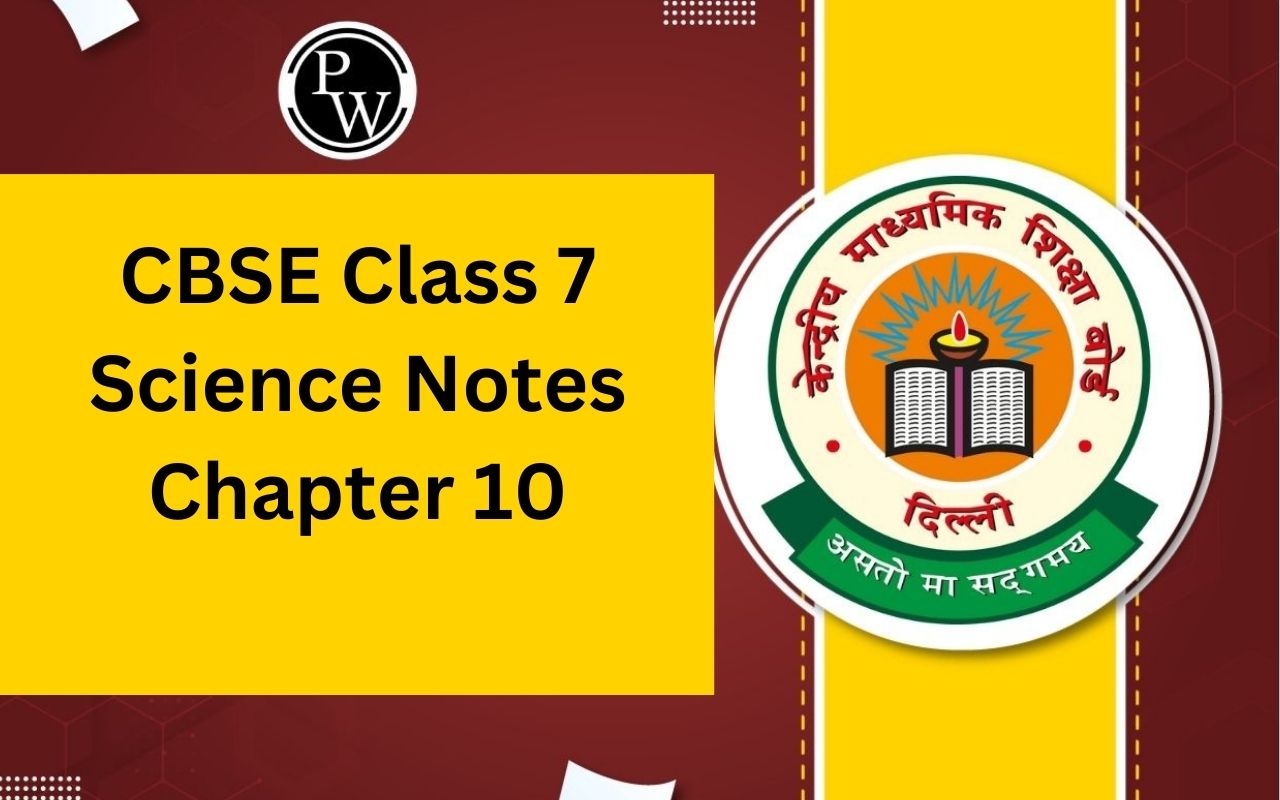

CBSE Class 7 Science Notes Chapter 10: Organisational Respiration The purpose of the class 7 notes is to assist students in rereading the chapter and getting ready for their tests. Our specialists have meticulously selected the revision notes following a thorough analysis of the chapter. They cover all the important subjects on which exam questions can be based and have been created in compliance with the most recent curriculum.
To comprehend the specialized knowledge in higher classes, students must master the fundamentals of science in class 7. The students will be able to quickly go over the entire chapter without losing any crucial information with the aid of the NCERT Solutions Class 7 Science notes on respiration in organisms. The students will benefit from the explanations provided in a comprehensive manner as they formulate their responses to topic-based questions.CBSE Class 7 Science Notes Chapter 10 Overview
Exam question papers cover the important and crucial subjects covered in each chapter, and occasionally students struggle to determine how much time to devote to each topic. The notes for Ch. 10 Science, Class 7, will assist students in identifying key concepts and facilitate their understanding of them. Prior to exams, students always have a limited amount of time. By reviewing these brief notes, they can avoid wasting that time reading the entire chapter. Students can also get assistance in creating well-formatted answers by using the notes from Science Chapter 10 of Class 7. Students can use these notes to organise the information in a point-by-point style when composing their exam responses. The notion of respiration is defined succinctly and clearly in Notes on Respiration in Organisms, Class 7. During respiration, glucose is broken down into carbon dioxide and water using the oxygen we breathe in. Energy is released as a result of this process. For additional information, students can consult the NCERT Class 7 Science Chapter 10 notes to understand the definition and mechanism of respiration. Students can expand on the explanations of the breathing process and its significance during tests, as they are simple to recall.CBSE Class 7 Science Notes Chapter 10 PDF
Here we have provided CBSE Class 7 Science Notes Chapter 10 for the ease of students so that they can just download the pdf and use it easily without the internet. These CBSE Class 7 Science Notes Chapter 10 will help students understand the chapter better.CBSE Class 7 Science Notes Chapter 10 PDF
CBSE Class 7 Science Notes Chapter 10
Why do we respire?
Cells, which are little units of matter, make up every living thing. In these creatures, these cells have several tasks to complete, including transportation, excretion, respiration, and digesting. Only when the cells receive the necessary energy can they carry out this task. Because food provides them with the energy they need, all living things require it. When organisms breathe, the energy contained in the meal is released.How food helps us in gaining energy?
We breathe in oxygen-containing air and exhale carbon dioxide-containing air as we breathe. When this oxygen enters our cells, it aids in the digestion of food and provides us with energy.Breathing vs. Respiration
Respiration
The process by which an organism exchanges gases is called respiration. On a cellular level, however, respiration is the process by which food is burned to produce energy.Breathing
The process by which an organism takes in oxygen and releases carbon dioxide is called breathing. Every living thing breathes in a different way. All people breathe through their lungs. Fish and other similar organisms breathe through their gills.Process of respiration
The blood absorbs the oxygen in the lungs. The body then uses this oxygen to reach every part of it. Blood absorbs carbon dioxide and returns it to the lungs while also supplying oxygen to the cells.Diffusion
The transfer of molecules from a region of lower concentration to one of higher concentration without the use of energy is known as diffusion. When an ink drop is submerged in water, it slowly and consistently mixes with the water through a process known as diffusion. Animals breathe by exchanging gases using the same method.Cellular respiration
The oxygen that the cells take up from the blood is used up by them to burn the food. Food burning releases energy, which is kept in reserve as ATP. Thus, burning food and using oxygen to produce energy is what is meant by respiration at the cellular level.Aerobic vs. Anaerobic
Aerobic respiration
The type of respiration in which organisms use oxygen for burning food inside the cell is called aerobic respiration.
Anaerobic respiration
Respiration in a cell in the absence of oxygen is called anaerobic respiration.Inhalation
The diaphragm descends and the ribs rise and expand during inhalation, expanding the chest cavity's volume. The result is a flow of air through the lungs.
Exhalation
The diaphragm returns to its original position after exhale, and the ribs migrate inward and downward, shrinking the chest cavity. As a result, air begins to exit the lungs.
As a result, air begins to exit the lungs.
Why do we feel hungry after doing a physical activity like walking or running?
The food that is already in our bodies gets transformed into energy when we exercise. We become hungry because all of the food is eaten in the process of producing energy. Therefore, we must eat more food in order to obtain more energy.Why do we sneeze?
The air we breathe in from our surroundings occasionally contains a variety of undesirable substances, like dust and smoke. Some of them can pass through the nasal cavity, but most of them become lodged in the hair in our nostrils. They thus irritate our nasal passages, causing us to sneeze. This aids in clearing the nasal cavity of undesired particles.Why can plants die if overwatered?
We are aware that the dirt provides oxygen to the roots. We also know that air exists in the spaces between the soil's particles. Soil contains some water, or moisture, in addition to air. The gaps between the soil particles become plugged when we overwater the plants. The plant may eventually perish as a result of the roots not being able to access enough air.
How Do We Breathe?
Components of the respiratory system in Humans
The respiratory system of the humans have several parts; the Nasal chamber, pharynx, larynx, trachea, bronchi, lungs, and diaphragm.The process of respiration in humans
Human respiration begins with breathing in air through the nose, which is followed by the lungs' transport of oxygen into the circulation. All of the cells receive this oxygen, which they use to burn glucose and produce energy.Respiration in Humans
Via the nostrils, inhaled air enters the nasal cavity, which is followed by the windpipe that leads to the lungs. A part of respiration is breathing, which is the process by which an organism inhales carbon dioxide-rich air and exhales oxygen-rich air. diverse animals have diverse respiratory systems for exchanging gases. When we breathe in, our lungs expand, and when we exhale, the air leaves our bodies, our lungs contract. Increasing physical exertion quickens the respiratory rate. Animals like cows, buffaloes, dogs, and cats have similar respiratory systems and breathing processes to humans.Respiration in microorganisms
Amoeba uses a mechanism called diffusion to breathe through the skin's surface. Animal respiration on land A cockroach's body is covered with tiny holes called spiracles on the sides. Through spiracles, the oxygen-rich air enters. For gaseous exchange, the spiracles are linked to a system of tubes known as tracheae.Respiration in aquatic animals
 Frogs breathe by means of their skin and lungs.
Fish breathe using unique structures called gills.
Frogs breathe by means of their skin and lungs.
Fish breathe using unique structures called gills.
Respiration in Animals
The way that animals breathe varies according on their personalities. For example: Earthworms breathe through their skin. Insects breathe via their whole body surface. Fish breathe through their gills. In the water, frogs breathe through their smooth, thin skin; on land, they do so through their lungs.Respiration in Plants
The way that animals breathe varies according on their personalities. For example: Earthworms breathe through their skin. Insects breathe via their whole body surface. Fish breathe through their gills. In the water, frogs breathe through their smooth, thin skin; on land, they do so through their lungs.Respiration in other organisms
Other organisms use specific organs to carry out their respiration. Fish have gills, frogs and earthworms use their moist skin, while insects have spiracles.Gaseous exchange in plants
Plants exchange gases through their roots' root hair and their leaves' stomata. Lenticels are also present in woody plant stems to facilitate the exchange of breathing gases.Benefits of CBSE Class 7 Science Notes Chapter 10
The greatest resources for comprehending and practicing the material are our Revision Notes for Class 7 Chapter 10 Respiration in Organisms. Every element and point are covered in detail in the material. The simplest solution for each situation in the material provides a clear explanation of the word. The primary subjects are covered in our Revision Notes for Class 7 Chapter 10 - Respiration in Organisms, allowing students to concentrate and become ready for the test.CBSE Class 7 Science Notes Chapter 10 FAQs
Why do we respire class 7 notes?
Respiration is required for living organisms to survive. It takes energy from the food and releases it. Glucose is broken down into carbon dioxide and water with the oxygen we breathe. In the process, energy is released.
What is a short note on respiration in organisms?
Respiration is a metabolic process that occurs in all organisms. It is a biochemical process that occurs within the cells of organisms. In this process, the energy (ATP-Adenosine triphosphate) is produced by the breakdown of glucose which is further used by cells to perform various functions.
Why do we respire class 7 pdf?
Organisms respire to get energy from food. During respiration energy is released from food and this takes place inside the cells of the body. Oxygen of air taken inside the cells is used for breaking down of food and energy is released by burning food.
🔥 Trending Blogs
Talk to a counsellorHave doubts? Our support team will be happy to assist you!

Check out these Related Articles
Free Learning Resources
PW Books
Notes (Class 10-12)
PW Study Materials
Notes (Class 6-9)
Ncert Solutions
Govt Exams
Class 6th to 12th Online Courses
Govt Job Exams Courses
UPSC Coaching
Defence Exam Coaching
Gate Exam Coaching
Other Exams
Know about Physics Wallah
Physics Wallah is an Indian edtech platform that provides accessible & comprehensive learning experiences to students from Class 6th to postgraduate level. We also provide extensive NCERT solutions, sample paper, NEET, JEE Mains, BITSAT previous year papers & more such resources to students. Physics Wallah also caters to over 3.5 million registered students and over 78 lakh+ Youtube subscribers with 4.8 rating on its app.
We Stand Out because
We provide students with intensive courses with India’s qualified & experienced faculties & mentors. PW strives to make the learning experience comprehensive and accessible for students of all sections of society. We believe in empowering every single student who couldn't dream of a good career in engineering and medical field earlier.
Our Key Focus Areas
Physics Wallah's main focus is to make the learning experience as economical as possible for all students. With our affordable courses like Lakshya, Udaan and Arjuna and many others, we have been able to provide a platform for lakhs of aspirants. From providing Chemistry, Maths, Physics formula to giving e-books of eminent authors like RD Sharma, RS Aggarwal and Lakhmir Singh, PW focuses on every single student's need for preparation.
What Makes Us Different
Physics Wallah strives to develop a comprehensive pedagogical structure for students, where they get a state-of-the-art learning experience with study material and resources. Apart from catering students preparing for JEE Mains and NEET, PW also provides study material for each state board like Uttar Pradesh, Bihar, and others
Copyright © 2025 Physicswallah Limited All rights reserved.










